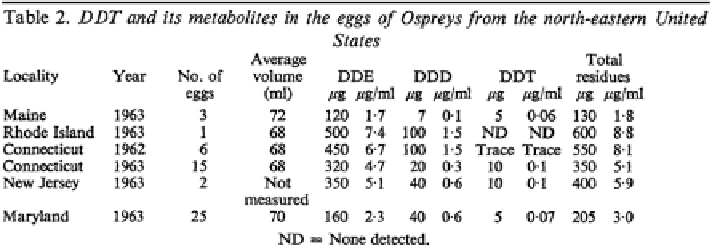Environmental Engineering Reference
In-Depth Information
reported total DDT levels of 2.5-9.2 ppm in scraps of fi sh cast from osprey nests on
Great Island near the mouth of the Connecticut River. Moreover, ospreys feeding in
the Connecticut River estuary in 1967 were poisoned by dieldrin (Wiemeyer et al.
1975
). These facts were known in 1972, but were not mentioned in the recommen-
dation. The recommendation of 50 ppb does not appear to have taken into account
all of the information available in 1972.
The above information sets the stage for considering the adoption of the NAS
fresh water and marine fi sh recommendations for use today, more than 40 years later.
Much has been learned about DDT and its effects on wildlife since 1972. The feeling
among investigators in 1972 was concern, frustration, and even outrage at what was
happening to avian species at the top of food chains. Within only a few years, how-
ever, recovery was well underway, and by 1980 was nearly complete in many species.
The study of the recovery of the sensitive avian species indicates that toxicity thresh-
olds do exist for DDT residues in fi sh diets. The results of such studies provide a way
of observing dose-response over time as residues slowly declined. However, the rela-
tionship between fi sh and egg residues became less certain as levels in the United
States declined below probable but unknown levels on wintering grounds in Latin
America, where DDT use continued, even until today. The following chronology will
focus on some of the key studies documenting the decline and recovery of the osprey,
since this species is key to the NAS panel's recommendation for marine fi sh. Some
of the earlier studies have been reviewed by Ware (
1975
).
Ames and Mersereau (
1964
) and Ames (
1966
) reported on the status of the osprey
along the Atlantic coast. Most populations were experiencing dramatic declines asso-
ciated with poor hatching and fl edgling rates. Eggs and fi sh remnants from nests on
Great Island at the mouth of the Connecticut River were assayed for DDT and metab-
olites in 1962. Eggs contained an average of 8.1
g/ml (about 9 ppm fresh weight)
total DDT and fi sh remnants cast from the osprey nests contained 2.5-9.2 ppm total
DDT. A crude biomagnifi cation factor would be 9/5.7 = 1.6.
In 1963, Ames (
1966
) again studied osprey eggs from Great Island, and did a
comparison with eggs from Maryland, where Ospreys were experiencing greater
reproductive success. A few eggs from other locations along the Atlantic coast were
also analyzed for DDT. The results are reproduced below in Table
8
.
ʼ
Table 8
DDT in osprey eggs from Northeastern United States. Table 2 in Ames (
1966
) reproduced
with permission

Search WWH ::

Custom Search